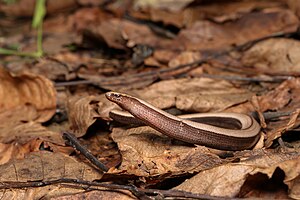Greek slow worm
| Greek slow worm | ||||||||||||
|---|---|---|---|---|---|---|---|---|---|---|---|---|

A Greek slow worm ( Anguis graeca ) |
||||||||||||
| Systematics | ||||||||||||
|
||||||||||||
| Scientific name | ||||||||||||
| Anguis graeca | ||||||||||||
| Bedriaga , 1881 |
The Greek slow worm ( Anguis graeca ) is a species of reptile from the sneak family and lives in the southern part of the Balkan Peninsula .
features
The Greek slow worm is very similar to the western slow worm . It has a legless, elongated body. Sometimes a small outer ear opening can be seen, in the middle of the body there are usually 26–28 longitudinal rows of scales. The males are greyish, light brown or reddish-brown on the upper side. Some animals have small dark blue spots on their backs. The females have a light, brownish upper surface that is set off from the dark flanks. A dark line usually runs across the middle, which can also be designed as a fine double line. Young animals are very light on top, whitish to pale yellowish, golden or silver-gray and with a narrow, black-brown central line. There is often a teardrop-shaped, dark brown spot on the head. Since the species was delimited from other species according to molecular biological methods because of its genetic distance, there is no precise information about the morphological distinguishing features. The most reliable way of determining the species is by where it was found.
Types of confusion
In the northern Peloponnese , the species occurs together with the Peloponnese blindworm, which can be distinguished from the Greek blindworm by a jagged longitudinal line in the front part of the body. In the western slow-worm, the ear opening is usually not externally visible and the number of longitudinal rows of scales in the middle of the body is typically less, 24–26.
distribution
The Greek slow worm is found in Greece , Albania , North Macedonia , Montenegro and Kosovo . In Greece it is replaced by the Peloponnese blindworm in the south of the Peloponnese and on the islands of Kefalonia and Zakynthos and by the western blindworm east of the 24th degree of longitude .
habitat
From sea level to over 1600 m above sea level on Olympus . The species prefers to inhabit meadows and forest edges on a slight slope with hiding places. But also near the beach pine forests, olive groves and stone terraces are settled.
Way of life
Depending on the local climate, the species is active from March to November. The pairings take place from April to May. The reproductive biology and behavior correspond to that of the western slow worm .
Danger
Since the species was still considered a subspecies of the western slow worm until 2010, little is known about its endangerment. In the Red List of North Macedonia the species is classified as not endangered ( least concern ).
Individual evidence
- ↑ Dieter Glandt: The amphibians and reptiles of Europe: All kinds in portrait. 2nd, updated and expanded edition. Quelle & Meyer, Wiebelsheim 2015, ISBN 978-3-494-01581-1 , pp. 329-330.
- ↑ http://redlist.moepp.gov.mk/slow-worm/
literature
- Dieter Glandt: The amphibians and reptiles of Europe: All kinds in portrait. 2nd, updated and expanded edition. Quelle & Meyer, Wiebelsheim 2015, ISBN 978-3-494-01581-1 , pp. 329-330.
Web links
- Anguis graeca in The Reptile Database . Edited by: P. Uetz, P. Freed & J. Hošek, 1995–2020. Retrieved August 20, 2020.